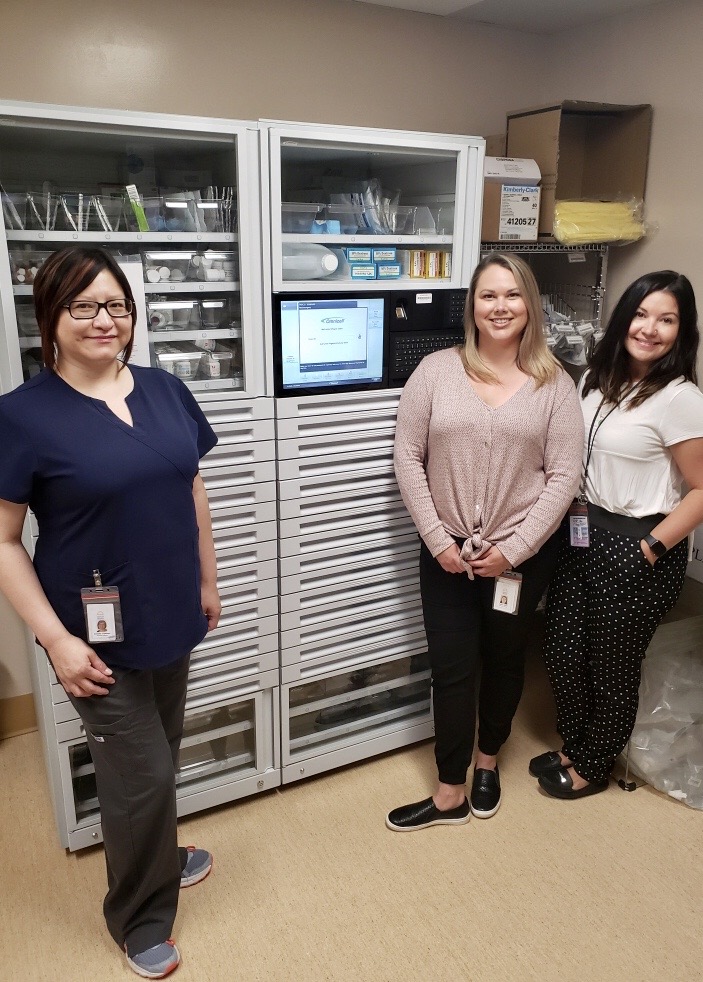Automated Medication Dispensing Machine Offers Patients' Medications Faster and Safer
Published Tuesday, July 28, 2020

New Automatic Dispensing Cabinets, funded thanks to donors, provide the right dose and right medications, increasing patient safety. Proudly showcasing one of these Automated Medication Dispensing Machines are (left to right): Jennifer Copenace, RPhT - Omnicell Pharmacy Superuser, Jessica Munn, RPhT - Omnicell Systems Administrator and Automation Lead, and Katie O'Quinn, BScN, RN - Clinical Nurse Specialist-Surgical and Ambulatory Services.
By Heather Vita
If you’ve ever been a patient at the Hospital, you’ve likely seen different equipment like vital signs monitors, perhaps an X-ray machine or a CT scanner. But it’s likely you’ve not seen (or paid attention to), Automatic Dispensing Cabinets for medications.
So what are they exactly? Jessica Munn, Pharmacy Technician and Omnicell Administrator explains, “They are large scale cabinets with a combination of secure drawers and shelves that are operated by a touch screen computer system. All medications are stored in single item secure bins. When an authorized user like a Registered Nurse or Respiratory Therapist needs a medication for a patient, only the correct item, ordered by a physician, will be available to remove. Each medication is supplied by Pharmacy using unique barcodes to make sure it is the correct medication. “
Munn says, “The Cabinets provide a greatly enhanced process for both the staff and patients. Once a medication is ordered, the order is reviewed by a Pharmacist. The medication then becomes available from the Cabinet immediately. Staff can access the medication right away and provide to their patients.”
New Cabinets were recently installed in several in-patient Units thanks to donors who provided the funds for a $200,000 grant from the Thunder Bay Regional Health Sciences Foundation. “We’re very grateful to donors in our community who are helping to expand our use of these Cabinets,” says Munn.
In addition to providing medications faster, the Cabinets enhance patient safety by minimizing the chance for medication errors. “Since only the medication that’s been ordered is available for users to remove, it greatly decreases the chance that an incorrect medication will be provided to a patient. Staff are guided by lights on the Cabinet to get to the medication they require. Larger items that require shelf space behind a secure door, are kept separate from other look-a-like, sound-a-like products.”
When the Cabinets are initially installed, the Pharmacy team looks to the needs of the patient in a particular area to select what medications should be added. Munn explains, “The Cabinets hold about 500 different medications out of about 4,000 that we have in stock at the Hospital. But as you can imagine, what a neurology patient needs will be different than what an oncology patient requires. We also ensure that the Cabinets are filled with common home medications like Tylenol and Aspirin.”
For the Pharmacy team, the Cabinets provide enhanced reporting and auditing. “One of the most exciting things for us is that we can audit every single transaction from the Cabinet,” says Munn. “This means we can track medication inventory much more closely to ensure that we top up stores of a particular medication when it’s running low. Additionally we can ensure that medications that aren’t being used frequently don’t expire and we’ll stock less of those in the Cabinet. We also run different reports looking for various trends and we get scores related to any exceptions or anomalies in workflow that may require attention.”
Most importantly, there’s multiple safety checks built in related to narcotics,” adds Munn. “The cabinets are equipped with an external Controlled Substance Dispenser that can house up to 30 cassettes that will provide the correct ordered dose into a single drawer for nursing to remove, alleviating the need to access more inventory than ordered. Pharmacy is dedicated to storing as many items as possible in these secured dispensers. In addition, the Omnicell system has sophisticated auditing and reporting to aid with the detection of diversion.”
For authorized users, there are benefits too. Sign in doesn’t require remembering a password, as it’s done with a fingerprint. Also, a user can cue up several medications orders at once from any computer on the Unit, with a program called Anywhere RN. They can then fill a patient’s order, provide it to the patient, and return to the Cabinet, without having to sit down at the computer again. The previously entered orders are stored in the software and they can then work to get the next patient’s medication.
Munn is looking forward to the day when there will be Automatic Dispensing Cabinets throughout the entire Hospital. “It will be amazing,” she says, “because they will all be connected to the computer system and users will be able to see where any medication is in stock. So, if a particular medication happens to be out on their Unit outside of pharmacy operating hours, they can see where it’s available, and go get it.”
Munn concludes, “These Cabinets are a huge step forward for our patients and for staff. I’m grateful to be involved in this project which directly impacts patient care is such a big way.”